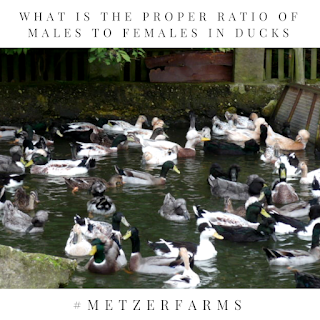Friday, October 5, 2018
Every now and again we receive orders for one male and one female of just about everything. Then 5-6 months later they are calling us saying they are having issues with their males ganging up on one specific female. We tell them right away that they have too many males and that their male to female ratio is completely off.
Here on the farm we have a 1:5 ratio of male to female since one male can easily ‘service’ 5 females. Problems typically occur when you have two or more males and an equal number of females or less.
For a backyard setup, look at our table for the maximum number of males to use. Of course, you do not need to have any males for them to lay eggs. You only need males for fertile eggs.
Males can become rather violent when it comes to mating, and if a female has multiple males trying to mate with her, she will be in danger of injury or even death.
As an example, we had one gentleman call us from New York and he had 3 male and 1 female duck. All 3 of the males were trying to mate with the female and she was not in good shape. She was suffering from losing an eye, bald spots, missing feathers, and trouble walking.
If you have too many males, there are a few things that can be done.
Here on the farm we have a 1:5 ratio of male to female since one male can easily ‘service’ 5 females. Problems typically occur when you have two or more males and an equal number of females or less.
For a backyard setup, look at our table for the maximum number of males to use. Of course, you do not need to have any males for them to lay eggs. You only need males for fertile eggs.
Males can become rather violent when it comes to mating, and if a female has multiple males trying to mate with her, she will be in danger of injury or even death.
As an example, we had one gentleman call us from New York and he had 3 male and 1 female duck. All 3 of the males were trying to mate with the female and she was not in good shape. She was suffering from losing an eye, bald spots, missing feathers, and trouble walking.
If you have too many males, there are a few things that can be done.

1. Reduce the number of males. This means rehousing the male(s). Your local feed store might be able to suggest some farms in your area you can contact or see if they would allow you to post a note on their bulletin board. You can place them up for adoption or sale on Craigslist. There is also the option of processing them for meat if that is something that interests you.
2. Get more females. To add females, check with your local feed store or Craisglist. You can also check with the person in charge of poultry at your local county fair and they can often recommend a farm. Hatcheries do not typically ship adult birds. If you get more female ducklings, remember they need to be 8-10 weeks of age before introducing them to the rest of the flock.
3. Increase the pen size and add things in which the females can hide – bushes, stacked branches, bales of hay, etc. This will allow more room for the females to escape the males.
4. Separate them.
Females can be put in danger if there are too many males trying to breed with them. The best thing is to not get too many males in the first place, but if you do have too many males, there are solutions to your problem.
2. Get more females. To add females, check with your local feed store or Craisglist. You can also check with the person in charge of poultry at your local county fair and they can often recommend a farm. Hatcheries do not typically ship adult birds. If you get more female ducklings, remember they need to be 8-10 weeks of age before introducing them to the rest of the flock.
3. Increase the pen size and add things in which the females can hide – bushes, stacked branches, bales of hay, etc. This will allow more room for the females to escape the males.
4. Separate them.
Females can be put in danger if there are too many males trying to breed with them. The best thing is to not get too many males in the first place, but if you do have too many males, there are solutions to your problem.
| Maximum Males We Recommend | ||
| Females You Have | Males in a Small Pen | Males in a Large Pen* |
| 1 | 1 | 1 |
| 2 | 2 | 2 |
| 3 | 2 | 2 |
| 4 | 2 | 2 |
| 5 | 2 | 3 |
| 6 | 3 | 4 |
| 7 | 3 | 4 |
| 8 | 3 | 5 |
| For larger numbers, divide the number of females by 4 or 5. The result is the maximum number of males the flock can have. | ||
| *Typical backyard size of 6000 sq ft | ||